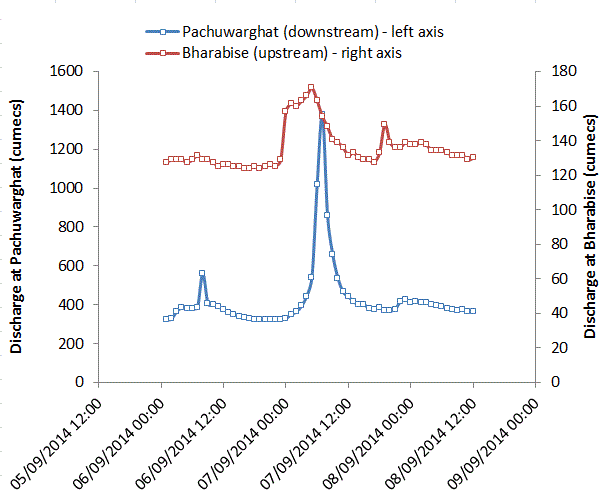8 September 2014
The Sunkoshi landslide dam breach
Posted by Dave Petley
The Sunkoshi landslide dam breach event
On Saturday night, apparently without warning, the landslide dam on the Sunkoshi River in Nepal abruptly breached, allowing the lake to mostly drain. This event appears to have occurred without warning, such that one of the Nepal Army excavators was washed away. The breach event appears to have been natural – a response to heavy rainfall – rather than a result of the attempts by the Nepal Army to widen the channel. Whilst some damage has been reported downstream, the flood does not appear to have been exceptionally large, so no casualties have been reported. Republica has a very nice set of photographs of the breached lake and dam:
.
Whilst Kapil Dhital (@bewitchkapil) tweeted this image of the lake this morning:
.
So what caused the breach? This is the gauging data for the Bharabise station (upstream of the dam) and the Pachuwaghat station (downstream). Note that the two sets of data use different y-axes. The flood peak generated by the breach event is very clear at Pachuwarghat, although this is not a very high peak. The Bharabise station probably responded to rainfall – there is a dramatic increase in discharge a few hours before the flood wave reached Pachuwarghat. Thus, it appears that the breach was initiated by this sudden increase in river flow in response to heavy rainfall:
This is clearer when the data for the few hours before the breach event are plotted:
.
In many ways this is the best possible outcome. The release of most of the water means that the hazard has in effect been removed, but without causing a huge amount of damage downstream. Unfortunately the huge amount of resource and effort that has gone into building the two new roads has been wasted. Once again I would reiterate my opinion that a focus on deepening the channel, rather than widening it and building new roads, would have been a much more effective way to manage this hazard. That the dam breached in a rainfall-induced event suggests that a targeted effort to deepen the channel could have resolved the crisis much earlier.








 Dave Petley is the Vice-Chancellor of the University of Hull in the United Kingdom. His blog provides commentary and analysis of landslide events occurring worldwide, including the landslides themselves, latest research, and conferences and meetings.
Dave Petley is the Vice-Chancellor of the University of Hull in the United Kingdom. His blog provides commentary and analysis of landslide events occurring worldwide, including the landslides themselves, latest research, and conferences and meetings.
Dave, the breach or opening was due to widening of secondary channel and few blasting on that channel on 6th September. Of course, heavy rainfall in the Bhote Koshi catchment enhanced the erosion on secondary channel. I was helping Nepal Army to open primary and secondary channels and on August 31, I suggested them to widen up the channel more than 30 m. With limited resources, Nepal Army widen up the channel and with minimum loss, the dam is opened! thanks for your continue support, specially reporting about this dam to the international platform. Thank you again!
Ranjan
Hi Dave, yesterday 19th September 2014, I walked across the Sunkoshi landslide, as at present, there are no roads available, although local people are building a new road using excavators on the same valley side of the landslide. The previous road, already reported by your blog has been abandoned and it had been built on the opposide valley side.
There are official porters helping people to carry bags and goods, it costs 10USD. The journey accross the landslide takes approximately 45 minutes and in places is challenging.
I took some pictures which I can email if you wish.
Best regards, Giorgio Maderni